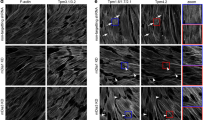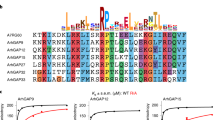Abstract
Wiskott–Aldrich syndrome protein (WASP) and N-WASP have emerged as key proteins connecting signalling cascades to actin polymerization. Here we show that the amino-terminal WH1 domain, and not the polyproline-rich region, of N-WASP is responsible for its recruitment to sites of actin polymerization during Cdc42-independent, actin-based motility of vaccinia virus. Recruitment of N-WASP to vaccinia is mediated by WASP-interacting protein (WIP), whereas in Shigella WIP is recruited by N-WASP. Our observations show that vaccinia and Shigella activate the Arp2/3 complex to achieve actin-based motility, by mimicking either the SH2/SH3-containing adaptor or Cdc42 signalling pathways to recruit the N-WASP–WIP complex. We propose that the N-WASP–WIP complex has a pivotal function in integrating signalling cascades that lead to actin polymerization.
This is a preview of subscription content, access via your institution
Access options
Subscribe to this journal
Receive 12 print issues and online access
$209.00 per year
only $17.42 per issue
Buy this article
- Purchase on Springer Link
- Instant access to full article PDF
Prices may be subject to local taxes which are calculated during checkout








Similar content being viewed by others
References
Miki, H., Minura, K. & Takenawa, T. N-WASP, a novel actin-depolymerizing protein, regulates the cortical cytoskeletal rearrangement in a PIP2-dependent manner downstream of tyrosine kinases. EMBO J. 15, 5326– 5335 (1996).
Symons, M. et al. Wiskott–Aldrich syndrome protein, a novel effector for the GTPase CDC42Hs, is implicated in actin polymerization. Cell 84, 723–734 ( 1996).
Derry, J. M. J., Ochs, H. J. & Francke, U. Isolation of a novel gene mutated in Wiskott–Aldrich syndrome. Cell 78, 635– 644 (1994).
Rohatgi, R. et al. The interaction between N-WASP and the Arp2/3 complex links Cdc42-dependent signals to actin assembly. Cell 97, 221–231 (1999).
Aspenström, P., Lindberg, U. & Hall, A. Two GTPases, Cdc42 and Rac, bind directly to a protein implicated in the immunodeficiency disorder Wiskott–Aldrich syndrome. Curr. Biol. 6, 70–75 (1996).
Miki, H., Sasaki, T., Takai, Y. & Takenawa, T. Induction of filopodium formation by a WASP-related actin-depolymerizing protein N-WASP . Nature 391, 93–96 (1998).
Abdul-Manan, N. et al. Structure of Cdc42 in complex with the GTPase-binding domain of the Wiskott–Aldrich syndrome protein. Nature 399, 379–383 (1999).
Rivero-Lezcano, O. M., Macillia, A., Sameshima, J. H. & Robbins, K. C. Wiskott–Aldrich syndrome protein physically associates with Nck through Src homology domains. Mol. Cell Biol. 15, 5725–5731 (1995).
She, H. et al. Wiskott–Aldrich syndrome protein is associated with the adapter protein Grb2 and the epidermal growth factor receptor in living cells. Mol. Biol. Cell 8, 1709–1721 (1997).
Carlier, M. F. et al. GRB2 links signalling to actin assembly by enhancing interaction of neural Wiskott–Aldrich syndrome protein (N-Wasp) with actin-related-protein ARP2/3 complex. J. Biol. Chem. (in the press).
Carlier, M-F., Ducruix, A. & Pantaloni, D. Signalling to actin: the Cdc42–N-WASP–Arp2/3 connection. Chem. Biol. 6, R235–R240 ( 1999).
Machesky, L. M. & Insall, R. H. Scar1 and the related Wiskott–Aldrich syndrome protein WASP regulate the actin cytoskeleton through the Arp2/3 complex. Curr. Biol. 8, 1347–1356 (1998).
Yarar, D., To, W., Abo, A. & Welch, D. M. The Wiskott–Aldrich syndrome protein directs actin-based motility by stimulating actin nucleation with the Arp2/3 complex. Curr. Biol. 9, 555–558 (1999).
Machesky, L. M. et al. Scar, a WASp-related protein, activates nucleation of actin filaments by the Arp2/3 complex. Proc. Natl Acad. Sci. USA 96, 3739–3744 (1999).
Blanchoin, L. et al. Direct observation of dendritic actin filament networks nucleated by Arp2/3 complex and WASP/Scar proteins. Nature 404 , 1007–1011 (2000).
Cudmore, S., Cossart, P., Griffiths, G. & Way, M. Actin-based motility of vaccinia virus. Nature 378, 636–638 (1995).
Frischknecht, F. et al. Actin based motility of vaccinia virus mimics receptor tyrosine kinase signalling. Nature 401, 926– 929 (1999).
Frischknecht, F. et al. Tyrosine phosphorylation is required for actin based motility of vaccinia but not Listeria or Shigella. Curr. Biol. 9, 89–92 (1999 ).
Murray, J. M. & Johnson, D. I. Isolation and characterization of Nrf1p, a novel negative regulator of the Cdc42p GTPase in Schizosaccharomyces pombe. Genetics 154, 155– 165 (2000).
Ory, S., Munari-Silem, Y., Fort, P. & Jurdic, P. Rho and Rac exert antagonistic functions on spreading of macrophage-derived multinucleated cells and are not required for actin fiber formation. J. Cell Sci. 113, 1177–1188 (2000).
Aktories, K. Rho proteins: targets for bacterial toxins. Trends Microbiol. 5, 282–288 (1997).
Schindelhauer, D. et al. Wiskott–Aldrich syndrome: no strict genotype–phenotype correlations but clustering of missense mutations in the amino-terminal part of the WASP gene product. Hum. Genet. 98, 68–76 (1996).
Fedorov, A. A., Fedorov, E., Gertler, F. & Almo, S. C. Structure of EVH1, a novel proline-rich ligand-binding module involved in cytoskeletal dynamics and neural function. Nature Struct. Biol. 6, 661–665 (1999).
Prehoda, K. E., Lee, D. J. & Lim, W. A. Structure of the Enabled/VASP homology 1 domain-peptide complex: a key component in the spatial control of actin assembly. Cell 97, 471–480 ( 1999).
Ramesh, N., Anton, I.E., Hartwig, J. H. & Geha, R. S. WIP, a protein associated with Wiskott–Aldrich syndrome protein, induces actin polymerization and redistribution in lymphoid cells. Proc. Natl Acad. Sci. USA 94, 14671–14676 (1997).
Stewart, D. M., Tian, L. & Nelson, L. D. Mutations that cause Wiskott–Aldrich syndrome impair the interaction of Wiskott–Aldrich syndrome protein (WASP) with WASP interacting protein. J. Immunol. 162, 5019–5024 (1999).
Anton, I. M., Lu, W., Mayer, B. J., Ramesh, N. & Geha, R.S. The Wiskott–Aldrich syndrome protein-interacting protein (WIP) binds to the adapter protein Nck. J. Biol. Chem. 273, 20992–20995 ( 1998).
Suzuki, T., Miki, H., Takenawa, T. & Sasakawa, C. Neural Wiskott–Aldrich syndrome protein is implicated in the actin based motility of Shigella flexneri. EMBO J. 17, 2767– 2776 (1998).
Egile, C. et al. Activation of the Cdc42 effector N-WASP by the Shigella flexneri IcsA protein promotes actin nucleation by Arp2/3 complex and bacterial actin-based motility. J. Cell Biol. 146, 1319–1332 (1999).
Loisel, T. P., Boujemaa, R., Pantaloni, D. & Carlier, M-F. Reconstition of actin based motility of Listeria and Shigella using pure proteins. Nature 401, 613–616 (1999).
Cudmore, S., Reckmann, I. & Way, M. Viral manipulations of the actin cytoskeleton. Trends Microbiol. 5, 142–148 (1997).
Dramsi, S. & Cossart, P. Intracellular pathogens and the actin cytoskeleton. Annu. Rev. Cell Dev. Biol. 14, 137–166 (1998).
Welch, M. D., Iwamatsu, A. & Mitchison, T. J. Actin polymerization is induced by Arp2/3 protein complex at the surface of Listeria monocytogenes. Nature 385 , 265–269 (1997).
Carlier, M.-F. et al. Actin depolymerizing factor (ADF/cofilin) enhances the rate of filament turnover: implication in actin-based motility. J. Cell Biol. 136, 1307–1323 ( 1997).
Rosenblatt, J., Agnew, B. J., Abe, H., Bamburg, J. R. & Mitchison, T. J. Xenopus actin depolymerizing factor/cofilin (XAC) is responsible for the turnover of actin filaments in Listeria monocytogenes tails. J. Cell Biol. 136, 1323– 1332 (1997).
Welch, M. D., Rosenblatt, J., Skole, J., Portnoy, D. A. & Mitchison, T. J. Interaction of human Arp2/3 complex and the Listeria monocytogenes ActA protein in actin filament nucleation. Science 281, 105–108 ( 1998).
Imai, K., et al. The pleckstrin homology domain of the Wiskott–Aldrich syndrome protein is involved in the organization of actin cytoskeleton. Clin. Immunol. 92, 128–137 (1999).
May, R. C. et al. The Arp2/3 complex is essential for the actin-based motility of Listeria monocytogenes. Curr. Biol. 9, 759–762 (1999).
Banin, S. et al. Wiskott–Aldrich syndrome protein (WASp) is a binding partner for c-Src family protein tyrosine kinases. Curr. Biol. 6, 981–988 (1996).
Ma, L., Rohatgi, R. & Kirschner, M. W. Biochemical purification of factors that mediate Cdc42-induced actin polymerization. Mol. Biol. Cell 10, (suppl.) 384a (1999).
Li, R. Bee1, a yeast protein with homology to Wiskott–Aldrich syndrome protein, is critical for the assembly of cortical actin cytoskeleton. J. Cell Biol. 136, 649–658 ( 1997).
Naqvi, S. N., Zahn, R., Mitchell, D. A., Stevenson, B. J. & Munn, A. L. The WASp homologue Las17p functions with the WIp homologue End5p/verprolin and is essential for endocytosis. Curr. Biol. 8, 959–962 ( 1998).
Vaduva, G., Martin, N. C. & Hopper, A. K. Actin-binding verprolin is a polarity development protein required for morphogenesis and function of the yeast actin cytoskeleton . J. Cell Biol. 139, 1821– 1833 (1997).
Madania, A. et al. The Saccharomyces cerevisiae homologue of human Wiskott–Aldrich syndrome protein Las17p interacts with the Arp2/3 complex. Mol. Biol. Cell 10, 3521–3538. (1999).
Anderson, B. L. et al. The Src homology domain 3 (SH3) of a yeast type I myosin, Myo5p, binds verprolin and is required for targeting to sites of actin polymerization . J. Cell Biol. 141, 1357– 1370 (1998).
Lechler, T., Shevchenko, A., Shevchenko, A. & Li, R. Direct involvement of yeast type I myosins in Cdc42-dependent actin polymerization . J. Cell Biol. 148, 363– 373 (2000).
Evangelista, M. et al. A role for myosin-I in actin assembly through interactions with Vrp1p, Bee1p and the Arp2/3 complex. J. Cell Biol. 148, 353–362 (2000).
Le Bot, N., Antony, C., White, J., Karsenti, E. & Vernos, I. Role of Xklp3, a subunit of the Xenopus kinesin II heterotrimeric complex, in membrane transport between the endoplasmic reticulum and the Golgi apparatus. J. Cell Biol. 143, 1559 –1573 (1999).
Clerc, P. & Sansonetti, P. J. Entry of Shigella flexneri into HeLa cells: evidence for directed phagocytosis involving actin polymerization and myosin accumulation. Infect. Immun. 55, 2681 –2688 (1987).
Drechsel, D. N., Hyman, A. A., Hall, A. & Glotzer, M. A requirement for Rho and Cdc42 during cytokinesis in Xenopus embryos. Curr. Biol. 7, 12–23 (1996).
Acknowledgements
We thank H. Miki (University of Tokyo) for providing rat N-WASP cDNA and anti-N-WASP antibody, and A. Hall (University College London) for human Cdc42 and Rac1 templates used for PCR and the GST–Cdc42(L61) expression construct. We also thank P. Sansonetti (Institut Pasteur, Paris), G. Smith (University of Oxford) K. Aktories (Freiburg, Germany), N. Le Bot (EMBL) and G. Stier (EMBL) for providing Shigella, vaccinia strain ΔA36R, Toxin B, anti-GFP antibody and modified pET24b vector, respectively. We thank A. Desai and G. Superti-Furga for critical reading of the manuscript.
Correspondence and requests for materials should be addressed to M.W.
Author information
Authors and Affiliations
Corresponding author
Rights and permissions
About this article
Cite this article
Moreau, V., Frischknecht, F., Reckmann, I. et al. A complex of N-WASP and WIP integrates signalling cascades that lead to actin polymerization. Nat Cell Biol 2, 441–448 (2000). https://doi.org/10.1038/35017080
Received:
Revised:
Accepted:
Published:
Issue Date:
DOI: https://doi.org/10.1038/35017080
This article is cited by
-
Virus interactions with the actin cytoskeleton—what we know and do not know about SARS-CoV-2
Archives of Virology (2022)
-
Macrophage mitochondrial fission improves cancer cell phagocytosis induced by therapeutic antibodies and is impaired by glutamine competition
Nature Cancer (2022)
-
The Campylobacter jejuni CiaD effector co-opts the host cell protein IQGAP1 to promote cell entry
Nature Communications (2021)
-
NPF motifs in the vaccinia virus protein A36 recruit intersectin-1 to promote Cdc42:N-WASP-mediated viral release from infected cells
Nature Microbiology (2016)
-
WIP and WICH/WIRE co-ordinately control invadopodium formation and maturation in human breast cancer cell invasion
Scientific Reports (2016)



